In late 2003, the artist James Rosenquist who died on 31 March aged 83, told us about seeing his large-scale works return to New York for a retrospective at the Guggenheim Museum, which later travelled to the Guggenheim Museum Bilbao. He recalled first seeing Old Masters at the Art Institute of Chicago and earning a living in New York in the late 1950s painting billboards before he achieved success translating the imagery and scale of American advertising into memorable works on canvas, including a room-sized response to the Vietnam War, the 86-foor-long painting F-111 (1965).
The Art Newspaper: After you studied at the Art Students League you earned a living painting billboards before becoming a Pop artist.
James Rosenquist: I was so sick and tired of painting advertisements; I wasn’t celebrating it at all. You know, some critics say Pop artists love their subject matter…Bullshit! I just hated it. In 1957, I was working for General Outdoor Advertising having to paint this big whisky bottle above every candy store in Brooklyn. I got up to about number 50 and was so tired of doing the same shine on every bottle. There was a text on its label, “This spirit is made from finest grains”, and instead I wrote “Mary had a little lamb, its fleece was white as snow”. I painted 147 of the damn things. The other sign painters didn’t know what I was up to. We were once on the Expressway, painting a huge billboard all grey. I was 23, the other sign-painters were old guys. Without them knowing, I put in a little bit of green paint, some red, some yellow, into each of their pots. When we walked away, I said “Hey, you guys, look back there!” It had this beautiful patchwork effect, it reminds me now of a Jasper Johns. The other sign painters went, “Oh no! It must be some sort of weird chemistry! We’ll all get fired!”
As well as the Guggenheim retrospective, you have four solo shows in commercial galleries. How does it feel seeing such a huge body of your work all over New York?
Well, I had my first retrospective at the National Gallery of Ottawa in 1967 and I’ve had other retrospectives in Cologne and Chicago, but New York is the place. In 1991, I had a huge show in Moscow and the insurance for the whole damn show was only $58,000. [Guggenheim director] Thomas Krens asked me to have this show six years ago, when the economy was down; then there was the tragedy of the World Trade Center, so now insurance prices are sky high and the paintings have come from Europe each with its own individual courier. I look at these paintings of mine with these couriers, and it’s so funny that I sold them back then for $750, or maybe $1,000, and now they’re insured for $1 million. That’s really hilarious!
Presumably you have not seen some of these works for years?
Some I’ve not seen for decades and I’m amazed they’re in pretty good shape, because museums and people have really taken good care of them. Also, I use British oil paints that just last longer. At the 1963 World’s Fair in New York Philip Johnson asked me to do a big outdoor painting. I tested various brands of paint to see how they would stand up outside; some yellows turned to brown over a few years. But Windsor & Newton stand up years later, they are still bright against wind and sand. So I have a limited palate now of just nine Windsor & Newton colours and one Dutch, and that’s it.
Up close the texture of your paintings can be very lush, but in reproduction they look as if they could almost be done by spray can.
When I was young and hadn’t yet seen any Old Master paintings except in reproduction, I hitchhiked to the Art Institute in Chicago and realised for the first time that these were smeary, sloppy, heavily brushed paintings. They certainly didn’t look like that in the photographs I’d seen, and that was a real revelation. As I tell young people, some of the finest paintings in the world were done merely with raw minerals mixed in oil with hair from the back of a pig’s ear, with pig bristle. Some of the very finest drawings in the Albertina in Austria are made just with burnt wood on parchment. An amazing illusion can still be created from that simplicity.
• This is an edited version of an interview by Adrian Dannatt that first appeared in The Art Newspaper in November 2003


